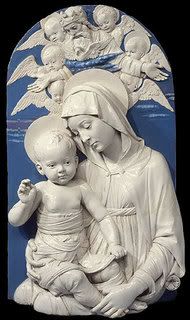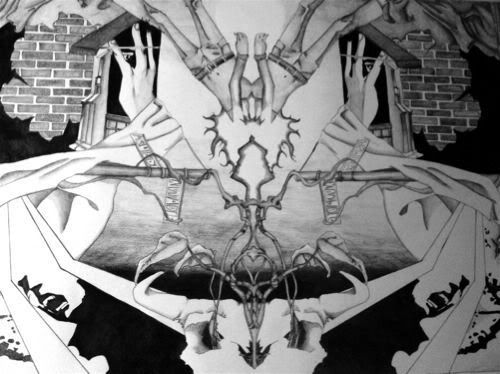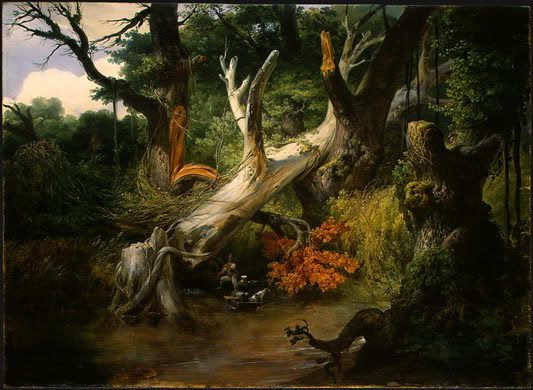Wednesday, June 27, 2007
Unfortunatly, I am having a lot of trouble with my color game so it is unavailable. Sorry.
Activity Five
Many artist create art with different themes.
Martin Johnson Heade's "Cattleya Orchid and Three Brazilian Hummingbirds", 1871, on oil wood, depicts an Art and Nature theme. Nature and Art theme is based on artworks about good old mother nature (74.) The title, the name the  artist gave this painting, supports the nature theme because states that you are viewing an orchid and hummingbirds which are a part of nature. While the subject, what the painting is of, nature and the main context is a large flower and three hummingbirds. This theme is aslo supported by different principles and elements of art. The figure, a shape you detach and focus on(89), a large beautiful flower grabs and holds your attention right away. The artist also uses color to enhance the theme. The background is painted primarily with warm colors, the green leaves and blue sky in the right corner (95). While the main focul points are highlighted with warm colors, the purple flower and the red, yellow and purple hummingbirds (95). Emphasis which is what our attention is drawn to(134), and large scale, which is larger than normal(136), help enhance our attention on the flower as well. Subordination, uses less detail in order to enhance something else(134), also keeps our attention on the flower and the hummingbirds because the background is rather dull and a bit drab. These key elements keep our attention focused on the what the artist wanted us to look at, nature.
artist gave this painting, supports the nature theme because states that you are viewing an orchid and hummingbirds which are a part of nature. While the subject, what the painting is of, nature and the main context is a large flower and three hummingbirds. This theme is aslo supported by different principles and elements of art. The figure, a shape you detach and focus on(89), a large beautiful flower grabs and holds your attention right away. The artist also uses color to enhance the theme. The background is painted primarily with warm colors, the green leaves and blue sky in the right corner (95). While the main focul points are highlighted with warm colors, the purple flower and the red, yellow and purple hummingbirds (95). Emphasis which is what our attention is drawn to(134), and large scale, which is larger than normal(136), help enhance our attention on the flower as well. Subordination, uses less detail in order to enhance something else(134), also keeps our attention on the flower and the hummingbirds because the background is rather dull and a bit drab. These key elements keep our attention focused on the what the artist wanted us to look at, nature.
 artist gave this painting, supports the nature theme because states that you are viewing an orchid and hummingbirds which are a part of nature. While the subject, what the painting is of, nature and the main context is a large flower and three hummingbirds. This theme is aslo supported by different principles and elements of art. The figure, a shape you detach and focus on(89), a large beautiful flower grabs and holds your attention right away. The artist also uses color to enhance the theme. The background is painted primarily with warm colors, the green leaves and blue sky in the right corner (95). While the main focul points are highlighted with warm colors, the purple flower and the red, yellow and purple hummingbirds (95). Emphasis which is what our attention is drawn to(134), and large scale, which is larger than normal(136), help enhance our attention on the flower as well. Subordination, uses less detail in order to enhance something else(134), also keeps our attention on the flower and the hummingbirds because the background is rather dull and a bit drab. These key elements keep our attention focused on the what the artist wanted us to look at, nature.
artist gave this painting, supports the nature theme because states that you are viewing an orchid and hummingbirds which are a part of nature. While the subject, what the painting is of, nature and the main context is a large flower and three hummingbirds. This theme is aslo supported by different principles and elements of art. The figure, a shape you detach and focus on(89), a large beautiful flower grabs and holds your attention right away. The artist also uses color to enhance the theme. The background is painted primarily with warm colors, the green leaves and blue sky in the right corner (95). While the main focul points are highlighted with warm colors, the purple flower and the red, yellow and purple hummingbirds (95). Emphasis which is what our attention is drawn to(134), and large scale, which is larger than normal(136), help enhance our attention on the flower as well. Subordination, uses less detail in order to enhance something else(134), also keeps our attention on the flower and the hummingbirds because the background is rather dull and a bit drab. These key elements keep our attention focused on the what the artist wanted us to look at, nature.Horace Vernet's, "Hunting in the Pontine Marshes", 1833, on oil canvas, aslo depicts a major theme. However, this paintings theme is looking inward: the human experience, which is art depicting what life is like (64.) This painting depicts this theme because the men in the boat are hunting which everyone in the world has to eat and these men are hunting which is described in the title. The subject of the painting is a boat traveling through the woods or marshes on a small river. Like Heade's painting, many design elements and principles of art help enhance the paintings theme. Unlike Heade, Vernet used direction and movement (84) in order to bring our attention to the painting's main focus. The vertical direction of the white tree helps your eyes slope down to the hunters in the boat(85). Similar to Heade, Vernet uses color to enhance his focul point. However, he uses shades, colors darker than their original (96), of green to outline the painting and tints, colors lighter than thier original (96), to highlight the river, the fallen and broken tree and the hunters. Atmospheric perspective, suggest a receding landscape (113), also enhances the human experience theme because it gives the woods a never-ending look which is typical in real life. Vernet also uses emphasis and subordination just like Heade's painting(134). The outline which is not as visually stimulating, subordination, allows the viewer to pay more attention to the fallen tree and the hunters, emphasis. As we can see both artist used similar and different elements and principles to support thier completely different themes.
men in the boat are hunting which everyone in the world has to eat and these men are hunting which is described in the title. The subject of the painting is a boat traveling through the woods or marshes on a small river. Like Heade's painting, many design elements and principles of art help enhance the paintings theme. Unlike Heade, Vernet used direction and movement (84) in order to bring our attention to the painting's main focus. The vertical direction of the white tree helps your eyes slope down to the hunters in the boat(85). Similar to Heade, Vernet uses color to enhance his focul point. However, he uses shades, colors darker than their original (96), of green to outline the painting and tints, colors lighter than thier original (96), to highlight the river, the fallen and broken tree and the hunters. Atmospheric perspective, suggest a receding landscape (113), also enhances the human experience theme because it gives the woods a never-ending look which is typical in real life. Vernet also uses emphasis and subordination just like Heade's painting(134). The outline which is not as visually stimulating, subordination, allows the viewer to pay more attention to the fallen tree and the hunters, emphasis. As we can see both artist used similar and different elements and principles to support thier completely different themes.
 men in the boat are hunting which everyone in the world has to eat and these men are hunting which is described in the title. The subject of the painting is a boat traveling through the woods or marshes on a small river. Like Heade's painting, many design elements and principles of art help enhance the paintings theme. Unlike Heade, Vernet used direction and movement (84) in order to bring our attention to the painting's main focus. The vertical direction of the white tree helps your eyes slope down to the hunters in the boat(85). Similar to Heade, Vernet uses color to enhance his focul point. However, he uses shades, colors darker than their original (96), of green to outline the painting and tints, colors lighter than thier original (96), to highlight the river, the fallen and broken tree and the hunters. Atmospheric perspective, suggest a receding landscape (113), also enhances the human experience theme because it gives the woods a never-ending look which is typical in real life. Vernet also uses emphasis and subordination just like Heade's painting(134). The outline which is not as visually stimulating, subordination, allows the viewer to pay more attention to the fallen tree and the hunters, emphasis. As we can see both artist used similar and different elements and principles to support thier completely different themes.
men in the boat are hunting which everyone in the world has to eat and these men are hunting which is described in the title. The subject of the painting is a boat traveling through the woods or marshes on a small river. Like Heade's painting, many design elements and principles of art help enhance the paintings theme. Unlike Heade, Vernet used direction and movement (84) in order to bring our attention to the painting's main focus. The vertical direction of the white tree helps your eyes slope down to the hunters in the boat(85). Similar to Heade, Vernet uses color to enhance his focul point. However, he uses shades, colors darker than their original (96), of green to outline the painting and tints, colors lighter than thier original (96), to highlight the river, the fallen and broken tree and the hunters. Atmospheric perspective, suggest a receding landscape (113), also enhances the human experience theme because it gives the woods a never-ending look which is typical in real life. Vernet also uses emphasis and subordination just like Heade's painting(134). The outline which is not as visually stimulating, subordination, allows the viewer to pay more attention to the fallen tree and the hunters, emphasis. As we can see both artist used similar and different elements and principles to support thier completely different themes.Works Cited
Getlein, Mark. "Living With Art, eighth edition". New York 2008.
Labels: theme essay
Wednesday, June 20, 2007
Activity Four
Horace Vernet's "Hunting in the Pontine Marshes", 1833, oil canvas depicts many design bases including balance, scale and emphasis. The white tree in the middle of the painting holds the most visual weight (125.) The visual weight, tree, grabs the viewers attention and holds it. The artist used asymmetrical balance by evenly distributing a visual balance on both sides of the painting ( 129.) Each side of the painting is balanced, the boat is evened out with the broken trre branch and the other trees are evenly distributed on either side. The trees are on a larger scale than the river and the boat (137) Which means that the trees are not proportioned or size related to the size of the boat, they are extremely overwhelming (137.) The artist emphasizes the size of the trees by making them larger to show how small the men in the boat really are. Although this particular painting does not use a rhythm or pattern, it is unified by the woodland that surrounds it (122.)
Martin Johnson Heade's "Cattleya Orchid and Three Brazilan Hummingbirds", 1871, oil wood aslo depicts various design bases which includes balance, emphasis and scale. In this painting the flower holds the visual weight (125.) The size and color of the flower grab the viewers attention immediaetly. Fortunately, the painting is asymmetrically balanced by the small hummungbirds and tree branches (129.) Despite the flower's large size, the artist balanced the painting by placing a lot of smaller detail, birds and tree branches. The background of this painting is subordinate, less visually interesting, ( 134) which puts an emphasis, more attention, on the flower and the hummingbirds (134.) The flower is drawn in proportion, sizes fit each other, to the hummingbirds because (137) these birds are particularly small. However, the background is painted on a smaller scale than the flower (136.) Like Vernet, Heade's painting does not have a particular rhythm or pattern but it is unified by nature (122.)
Martin Johnson Heade's "Cattleya Orchid and Three Brazilan Hummingbirds", 1871, oil wood aslo depicts various design bases which includes balance, emphasis and scale. In this painting the flower holds the visual weight (125.) The size and color of the flower grab the viewers attention immediaetly. Fortunately, the painting is asymmetrically balanced by the small hummungbirds and tree branches (129.) Despite the flower's large size, the artist balanced the painting by placing a lot of smaller detail, birds and tree branches. The background of this painting is subordinate, less visually interesting, ( 134) which puts an emphasis, more attention, on the flower and the hummingbirds (134.) The flower is drawn in proportion, sizes fit each other, to the hummingbirds because (137) these birds are particularly small. However, the background is painted on a smaller scale than the flower (136.) Like Vernet, Heade's painting does not have a particular rhythm or pattern but it is unified by nature (122.)
Art 101 Musuem visit Activity two
Horace Vernet's "Hunting in the Pontine Marshes", 1833, oil canvas depicts various design bases such as shape, color, perspective and line. Your attention is first pulled to the white tree. This becomes the paintings figure, the main focus, because it stands out compared to the dark background or ground(89.) The background is comprised mainly of monochromatic color because the artist uses different variations of the color green (97.) This also contributes to the atmospheric perspective which gives the painting a look of ongoing woodland (113.) While the vertical lines of the vines hanging from the trees give the woods an enormous appearance in comparison to the small boat (85.) The artist also uses an intense or purity in color of orange in the leaves of the broken tree branch to redirect your attention to the small boat floating on the river(96.) Vernet used a restricted palette, very few colors, when he painted this picture ( 98.)
Martin Johnson Heade's "Cattleya Orchid and Three Brazilian Hummingbirds",1871, oil canvas also depicts various design bases such as shape, color, perspective and line. The shape and color of the flower stands out compared to the rest of the painting (87) which makes the main focus, figure, in this painting, the flower (89.) This painting aslo employs atmospheric perspective which gives the background a never ending appearance(113.) Unlike Vernet, Heade's background was painted with less intensity in order to bring more attention to the various hues in the flower and the hummingbirds (88.) The artist also used complimentary colors which are colors directly across from each other on the colorwheel, in order to compliment the flower with its stem (97.) While Vernet used a restricted palette, Heade used a variety of different colors, open palette , to paint this picture(98.)
Martin Johnson Heade's "Cattleya Orchid and Three Brazilian Hummingbirds",1871, oil canvas also depicts various design bases such as shape, color, perspective and line. The shape and color of the flower stands out compared to the rest of the painting (87) which makes the main focus, figure, in this painting, the flower (89.) This painting aslo employs atmospheric perspective which gives the background a never ending appearance(113.) Unlike Vernet, Heade's background was painted with less intensity in order to bring more attention to the various hues in the flower and the hummingbirds (88.) The artist also used complimentary colors which are colors directly across from each other on the colorwheel, in order to compliment the flower with its stem (97.) While Vernet used a restricted palette, Heade used a variety of different colors, open palette , to paint this picture(98.)
Monday, June 18, 2007
Creative Blog

This sculpture demonstrates asymmetrical balance because eventhough it is not the same image on both sides the picture is well balanced. There is an extra angel over the babies head and the legs under the baby compensate for the mothers larger size. (Virgin and Child, ca. 1470-1475, Andrea della Robbia.)
Labels: Creative Blog




